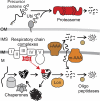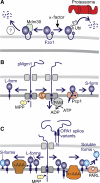Quality control of mitochondria: protection against neurodegeneration and ageing
- PMID: 18216873
- PMCID: PMC2234350
- DOI: 10.1038/sj.emboj.7601972
Quality control of mitochondria: protection against neurodegeneration and ageing
Abstract
Dysfunction of mitochondria has severe cellular consequences and is linked to ageing and neurodegeneration in human. Several surveillance strategies have evolved that limit mitochondrial damage and ensure cellular integrity. Intraorganellar proteases conduct protein quality control and exert regulatory functions, membrane fusion and fission allow mitochondrial content mixing within a cell, and the autophagic degradation of severely damaged mitochondria protects against apoptosis. Here, we will summarize the current knowledge on these surveillance strategies and their role in human disease.
Figures





Similar articles
-
Protein degradation within mitochondria: versatile activities of AAA proteases and other peptidases.Crit Rev Biochem Mol Biol. 2007 May-Jun;42(3):221-42. doi: 10.1080/10409230701380452. Crit Rev Biochem Mol Biol. 2007. PMID: 17562452 Review.
-
Control of mitochondrial integrity in ageing and disease.Philos Trans R Soc Lond B Biol Sci. 2014 Jul 5;369(1646):20130439. doi: 10.1098/rstb.2013.0439. Philos Trans R Soc Lond B Biol Sci. 2014. PMID: 24864310 Free PMC article. Review.
-
Mitochondrial protein quality control systems in aging and disease.Adv Exp Med Biol. 2010;694:108-25. doi: 10.1007/978-1-4419-7002-2_9. Adv Exp Med Biol. 2010. PMID: 20886760 Review.
-
Mitochondrial proteostasis in the context of cellular and organismal health and aging.J Biol Chem. 2019 Apr 5;294(14):5396-5407. doi: 10.1074/jbc.TM117.000893. Epub 2018 Apr 5. J Biol Chem. 2019. PMID: 29622680 Free PMC article. Review.
-
Mitochondrial dynamics in aging and disease.Prog Mol Biol Transl Sci. 2014;127:93-131. doi: 10.1016/B978-0-12-394625-6.00004-0. Prog Mol Biol Transl Sci. 2014. PMID: 25149215 Review.
Cited by
-
Two rare human mitofusin 2 mutations alter mitochondrial dynamics and induce retinal and cardiac pathology in Drosophila.PLoS One. 2012;7(9):e44296. doi: 10.1371/journal.pone.0044296. Epub 2012 Sep 5. PLoS One. 2012. PMID: 22957060 Free PMC article.
-
Oral Administration of Silibinin Ameliorates Cognitive Deficits of Parkinson's Disease Mouse Model by Restoring Mitochondrial Disorders in Hippocampus.Neurochem Res. 2021 Sep;46(9):2317-2332. doi: 10.1007/s11064-021-03363-5. Epub 2021 Jun 7. Neurochem Res. 2021. PMID: 34097239
-
Loss of mitochondrial peptidase Clpp leads to infertility, hearing loss plus growth retardation via accumulation of CLPX, mtDNA and inflammatory factors.Hum Mol Genet. 2013 Dec 15;22(24):4871-87. doi: 10.1093/hmg/ddt338. Epub 2013 Jul 12. Hum Mol Genet. 2013. PMID: 23851121 Free PMC article.
-
The peroxisome: an update on mysteries.Histochem Cell Biol. 2012 May;137(5):547-74. doi: 10.1007/s00418-012-0941-4. Epub 2012 Mar 14. Histochem Cell Biol. 2012. PMID: 22415027 Review.
-
Beneficial Effects of Low-Grade Mitochondrial Stress on Metabolic Diseases and Aging.Yonsei Med J. 2024 Feb;65(2):55-69. doi: 10.3349/ymj.2023.0131. Yonsei Med J. 2024. PMID: 38288646 Free PMC article. Review.
References
-
- Alexander C, Votruba M, Pesch UE, Thiselton DL, Mayer S, Moore A, Rodriguez M, Kellner U, Leo-Kottler B, Auburger G, Bhattacharya SS, Wissinger B (2000) OPA1, encoding a dynamin-related GTPase, is mutated in autosomal dominant optic atrophy linked to chromosome 3q28. Nat Genet 26: 211–215 - PubMed
-
- Baricault L, Segui B, Guegand L, Olichon A, Valette A, Larminat F, Lenaers G (2007) OPA1 cleavage depends on decreased mitochondrial ATP level and bivalent metals. Exp Cell Res 313: 3800–3808 - PubMed
-
- Barsoum MJ, Yuan H, Gerencser AA, Liot G, Kushnareva Y, Graber S, Kovacs I, Lee WD, Waggoner J, Cui J, White AD, Bossy B, Martinou JC, Youle RJ, Lipton SA, Ellisman MH, Perkins GA, Bossy-Wetzel E (2006) Nitric oxide-induced mitochondrial fission is regulated by dynamin-related GTPases in neurons. EMBO J 25: 3900–3911 - PMC - PubMed
Publication types
MeSH terms
Substances
LinkOut - more resources
Full Text Sources
Other Literature Sources
Medical

